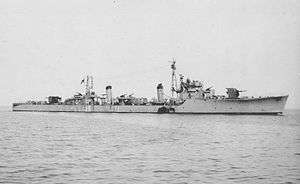Japanese destroyer Momi (1944)
 Momi on 4 September 1944 | |
| History | |
|---|---|
| Name: | Momi |
| Ordered: | 1944 |
| Laid down: | 2 February 1944 |
| Launched: | 16 June 1944 |
| Completed: | 3 September 1944 |
| Fate: | Sunk by air attack west of Manila 5 January 1945 |
| General characteristics | |
| Class and type: | Matsu-class destroyer |
| Displacement: |
|
| Length: | 100 m (328 ft 1 in) |
| Beam: | 9.35 m (30 ft 8 in) |
| Draft: | 3.3 m (10 ft 10 in) |
| Propulsion: |
|
| Speed: | 27.8 knots (32.0 mph; 51.5 km/h) |
| Range: | 3,500 nmi (6,500 km) at 18 kn (21 mph; 33 km/h) |
| Complement: | 211 |
| Armament: |
|
Momi (樅, translation: "Fir tree") was a Matsu-class destroyer of the Imperial Japanese Navy, sunk on 5 January 1945 by an American air attack west of Manila, in the South China Sea.
Operational history
On 27 September 1944 off Iturup in the Kurile Islands (45º44'N, 148º41'E), Momi was damaged by a torpedo from the submarine USS Searaven. Between 25 October and 2 November, together with the destroyer Hinoki, she escorted the aircraft carriers Ryūhō and Kaiyō on a transport mission from Sasebo to Keelung, then returned to Kure.
Momi sortied from Kure on 16 December 1944 as part of the escort for the aircraft carrier Unryū. The remainder of the escort consisted of the destroyers Shigure and Hinoki. Because an American invasion fleet had been spotted approaching the Philippine Islands, Unryū was intended to deliver a squadron of 30 Ohka kamikaze planes to Manila.
The task force sailed west through the Shimonoseki Straits to avoid American submarines, then turned south. On 19 December, the ship encountered the submarine USS Redfish, which sank Unryū, then submerged deep to escape the charging Hinoki. Shigure remained in the area to pick up survivors and unsuccessfully track down and sink the American submarine, while Hinoki and Momi shaped course for Japanese-occupied China. From there, they escorted Ikutagawa Maru to Manila, arriving on 4 January 1945.
The two destroyers were then ordered to withdraw to Taiwan, but were caught by American destroyers, including USS Bennion, on the afternoon of 5 January. They escaped 127 mm (5 in) gunfire and a spread of torpedoes fired from maximum range, but were caught by carrier-based aircraft from Task Force 77. A 454 kg (1,000 lb) bomb from an Douglas SBD Dauntless crippled Hinoki at 5:17 PM; and at 7:10 PM, a torpedo from a Grumman TBF Avenger struck Momi. She sank with all hands. (14°0′N 120°20′E / 14.000°N 120.333°ECoordinates: 14°0′N 120°20′E / 14.000°N 120.333°E)
References
- "Star-Crossed Sortie: The Last Voyage of Unryū and DesDiv 52" by Anthony Tully (retrieved January 16, 2007)
- "Matsu class 1st class destroyers" (retrieved January 16, 2007)
- IJN Momi: Tabular Record of Movement (retrieved October 20, 2009)